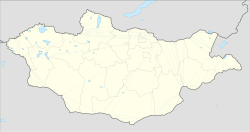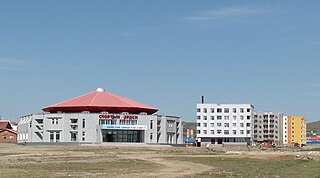| Baruunturuun District Баруунтуруун сум ᠪᠠᠷᠠᠭᠤᠨᠲᠤᠷᠤᠭᠤᠨᠰᠤᠮᠤ | |
|---|---|
| District | |
| Coordinates: 49°39′30″N94°23′57″E / 49.65833°N 94.39917°E Coordinates: 49°39′30″N94°23′57″E / 49.65833°N 94.39917°E | |
| Country | Mongolia |
| Elevation [1] | 1,232 m (4,045 ft) |
| Population (2008) | |
| • Total | 2,810 |
Baruunturuun (Mongolian : Баруунтуруун) is a sum in Uvs Province of Mongolia.

The Mongolian languageMoŋɣol kele; in Mongolian Cyrillic: монгол хэл, mongol khel) is the official language of Mongolia and both the most widely-spoken and best-known member of the Mongolic language family. The number of speakers across all its dialects may be 5.2 million, including the vast majority of the residents of Mongolia and many of the Mongolian residents of the Inner Mongolia Autonomous Region. In Mongolia, the Khalkha dialect, written in Cyrillic, is predominant, while in Inner Mongolia, the language is dialectally more diverse and is written in the traditional Mongolian script. In the discussion of grammar to follow, the variety of Mongolian treated is Standard Khalkha Mongolian, but much of what is to be said is also valid for vernacular (spoken) Khalkha and for other Mongolian dialects, especially Chakhar.

Uvs is one of the 21 aimags (provinces) of Mongolia. It is located in the west of the country, 1,336 kilometres or 830 miles away from the national capital Ulaanbaatar. Its capital is Ulaangom which lies 936 metres or 3,070 feet above sea level.
It is the heartland of grain production in the province,[ citation needed ] and lies on the bank of the Turuun River. The sum is also one of the most populous areas in the province. MIAT Mongolian Airlines flew to Baruunturuun directly from Ulan Bator until 2005, but stopped due to a plane shortage. Although the Baruunturuun Airport is not operational at the moment, it is considered the secondary airport of the province.[ citation needed ]
The Turuun River is a river of western Mongolia. It flows through the sum of Baruunturuun in Uvs Province.
MIAT Mongolian Airlines is the Mongolian national airline, headquartered in the MIAT Building in Ulaanbaatar, the capital of Mongolia. The airline operates international scheduled services from its base at Chinggis Khaan International Airport near Ulaanbaatar.









